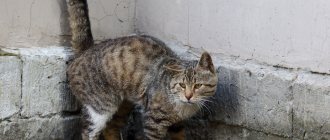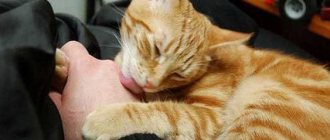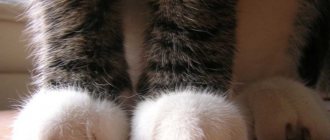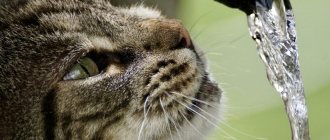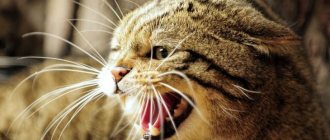Psychological reasons
The cat expresses the entire range of its emotions exclusively through body language, periodically supplementing it with several vocal variations available to it. There are few of them, but with their help the animal manages to convey to humans a huge number of experiences that need correct interpretation.
Predator instinct
It is embedded in every, even the most affectionate little cat, in whose veins the blood of distant forest ancestors flows. If you remind your cat of her hunting reflexes every day, don’t be surprised that over time she will turn into an angry, growling fury.
You have awakened a predator in your pet if it:
- jumps on your legs from ambush;
- does not respond to your shout, increasing the pressure;
- bites, hisses and scratches.
Correcting this behavior will be very difficult.
Social aggression
It occurs if a person annoys with excessive caresses. Any cat behaves quite coolly until it wants the owner’s tenderness. She will come up to attract attention, begin to rub against your legs, caress, prop up her back or ask to be held.
But tenderness (according to the cat) must be dosed - as soon as you overdo it with caresses, he will turn from an angel into a devil. At this moment, he is able to bite his hand, hiss and rattle his tail in displeasure, showing that the limit of his patience has been exhausted.
Frustration
This feline condition is akin to a human one and occurs when the pet’s desires do not coincide with its capabilities.
Injuries, illnesses
Your cat may look quite healthy, which does not at all exclude some diseases that are smoothed out or that arose not so long ago. Internal discomfort leads to unusual behavior, which is expressed, in particular, by unmotivated aggression.
This is interesting! If we are talking about illness, increased nervousness is often accompanied by refusal to eat/drink, apathy, frequent licking of fur and biting some parts of the body.
Tail biting
You may notice your pet trying to bite its tail and hear an angry hiss as it tries to prevent it. Sometimes the cat chews its tail at night, when everyone is lying down on the side.
The reasons for such a disorder can be various events:
- moving to a new apartment;
- birth of a baby;
- lack/decreased attention;
- other psychological trauma.
This kind of cat behavior must be stopped by getting to its source. Otherwise, the animal faces tail amputation.
Pregnancy
A cat growls and hisses when she is preparing to become a mother or immediately after giving birth to kittens, especially if a person has managed to undermine her trust. It will have to be restored, showing the pet that you will not hurt her or her offspring. As soon as the animal calms down, the aggressive attacks towards you will stop.
Anesthesia
A disruption in the cat’s usual behavior also occurs after undergoing general anesthesia. Animals have a hard time recovering from anesthesia and at this moment can behave very strangely, including hissing at their beloved owner. However, such a reaction is observed quite rarely, but no matter how the cat behaves, be there, stroke and calm it.
Common Causes
A cat hisses at a person in situations when it is trying to convey to him its experiences and emotions. Unlike people, cats are able to express their mood solely through body language, as well as vocal vibrations. If an animal is constantly unhappy and, at every opportunity, tries to hiss and growl not only at a stranger, but also at the owner, it is important to find out the reasons for this behavior.
Interesting!
There is a sign that says that if a cat hides or hisses at a stranger who has crossed the threshold of the house, it means that he wishes harm to the owner.
Predator instinct
An aggressive and hissing cat can even awaken to an affectionate, gentle purr, because in any breed of cat the blood of predators flows - the distant ancestors of domestic cats. If the owner begins to remind the pet every day about hunting reflexes, you should not be surprised that the animal will snort, arch its back, and rush at a potential hunting object at every opportunity.
A true predator lives in a pet if the following habits are observed every day:
- Hunting and jumping on the owner's legs from ambush;
- Lack of reaction to loud remarks, increased pressure;
- Constant aggression, attempts to bite and scratch painfully.
Interesting!
Felinologists do not recommend asking your pet to track the movements of its arms and legs under the blanket. Otherwise, the animal will get used to attacking without a reason and realizing that it was just a game.
Social aggression
Aggressive behavior is the result of excessive annoyingness and persistence of the owner. Every cat will want to let a person get close if it is in a bad mood or if the animal does not need affection at the moment. If a cat wants to communicate, he will independently approach the person, trying to make him pay attention to him.
Wanting communication, the purr will rub against your legs, ask for affection, offer its back to be stroked, or even jump into your arms. But if the owner overdoes it with affection, the cat will turn from a kind, gentle pet into a real devil. Therefore, it is important to try to find mutual understanding and not test each other’s patience.
This behavior is typical of cats that are frightened or angry by something in the presence of another person. Cats have excellent associative memory, so if a stranger or owner became unwitting accomplices of an unpleasant incident, when they meet, they will always evoke negative memories in the mustachioed cat, becoming the cause of aggression.
We suggest you read: Red eyes in a cat: why the eyelid swells and the color of the white changes, what to do depending on the cause
It's no wonder cats react so aggressively towards some people. Just by appearing, an uninvited guest causes unmotivated anger, manifested by hissing, growling, and snorting.
A cat's hissing and growling may be due to fears caused by insufficient socialization, or even worse - physical punishment. If the hissing is caused by fear, this will be indicated by the following factors:
- An attack on a person in the presence of a specific stimulus;
- Growling, attempts to mutilate with claws;
- Increased snorting and growling if the animal is cornered;
- Adopting aggressive warning postures;
- Final demonstrative licking of fur.
Interesting!
If a cat's fear began in childhood, it is important for the owner to pay special attention to raising the pet. You should be patient and love. This is the only way to teach your pet to adequately perceive events.
Most often, resentment accompanies a feeling of fear, but sometimes it arises on its own. If your pet hisses, growls, or twitches its tail when meeting a person, it is important to find out the reasons. Cats usually ignore the person who has offended them or try to show aggression openly. To make peace with your pet, you should communicate, apologize, and be sure to treat him with a treat as a sign of reconciliation and recognition of the mistake.
Domination
As soon as a cat gets into a new home, a hierarchical scheme with a leader at the head is immediately built in his head. It will be difficult for a family if the pet has defined itself as a dominant. In such a situation, the animal will immediately begin to show who is boss, using body language and vocal capabilities.
Interesting!
Not only an adult owner, but also a child can become a victim of cat aggression. Therefore, from the first days of a pet’s life in a new family, it is important for the owner to show that the cat is in a subordinate position and is not the “leader of the pack.”
If an animal develops any disease, then in addition to increased aggression, accompanied by hissing and growling, other symptoms will appear:
- Refusal of food and water;
- Apathy;
- Constant licking of fur;
- Biting certain parts of the body.
Some owners notice that their pet bites its tail, making angry hissing and growling sounds. The causes of such neurosis are often associated with the following events:
- Moving to a new home;
- The appearance of a newborn in the house;
- Lack of attention from the owner.
Pregnancy
Some cats hiss and growl before giving birth or immediately after the birth of their offspring. The animal shows particular aggression towards a person who has violated trust. In order to make peace with the pet, it is important for the owner to constantly show and prove that he will not harm the mother and babies. Once trust is restored, the animal will calm down and begin to respond normally to the person.
Anesthesia
An owner who decides to spay or neuter a pet should remember that after the operation the animal often behaves strangely, not recognizing its beloved owner and showing signs of aggression towards him in the form of hissing and growling. In such situations, the pet needs to be supported and reassured in every possible way. As soon as he recovers from anesthesia, his behavior will return to the same.
Why does a pet suddenly become aggressive and attack its owners?
Most often, aggressive behavior is not a pathological deviation, but a consequence of the emotional state of the animal
It is necessary not only to pay attention to the immediate circumstances that led to the manifestation of hostility, but also to look for reasons in the environment, in previous events, in the cat’s past. Patient observation of your pet will help you find triggers and take measures to eliminate them.
Reaction to pain and ill health
Pain is the most common cause of sudden aggression, especially in older or restless cats. Arthritis, dental disease, injury or infection are just some of the reasons that can cause aggressive behavior. In this case, the attack occurs not only after touching, but also when the suffering pet tries to prevent possible painful contact.
Other physiological conditions also lead to aggression. Cognitive decline, loss of normal sensory perception (hearing, vision, smell) or neurological problems distort instinctive mechanisms for recognizing danger.
Sudden fear or prolonged stress
Aggression can occur in a situation where the cat feels threatened or trapped. The fight-or-flight reflex involves the sympathetic nervous system: if there is nowhere to run, the only option is to fight. Having instantly mobilized all its physical capabilities, the cat rushes to attack, and therefore such cases are especially dangerous.
Long-term stress in cats is caused by both excessive attention and neglect on the part of the owner or mistress. Not all representatives of this genus can tolerate endless affection and contact with people
“Loved” pets are in a state of stress and can react with spontaneous hostility to violation of their personal space. Parting with the owner or limiting contact with him can also provoke outbursts of rage, the purpose of which is to attract attention to oneself.
Unpleasant changes: a new smell, rearrangement of furniture, appearance of a competitor
Adaptation to new conditions is another stress factor for a cat. The aggression that arises in connection with this is called status aggression. It may arise if the owner decides to move the pet to another room, change the feeding place, or introduce new rules of the hostel. Jealousy towards other pets can also cause sudden outbursts.
Redirected aggression occurs when a cat is scared or upset, but instead of going after the true object of concern, it turns its anger towards an easy target. To relieve excitement from an external and inaccessible stimulus - unpleasant noise, smell, game, competitors, she rushes at any person nearby.
Fight for freedom, food and territory
A pronounced sense of ownership is found in both females and males. This type of behavior, unlike normal and temporary maternal aggression, can create problems. The target of an attack can be not only animals or unfamiliar visitors, but also the owners themselves. For example, it is often said that a mustachioed villain attacked one of the family members after he was forced to sit behind a closed door. There are cases when an irritated pet deliberately bites its owner, who is trying to intervene in his conflict with competitors.
Many cats, deprived of human contact at an early age, perceive their presence as a threat and use their claws and teeth to put the “enemy” to flight. While on its territory, the unsociable predator bites and scratches the alien and calms down only after it manages to drive him away.
The cat growls and hisses – video
If a cat hisses at a kitten that has just been brought into the house, with this behavior she shows that she is the only one in charge here. The animal may behave aggressively towards the newcomer if he approaches personal belongings. This is how the pet shows that it is forbidden to use her things. Another common reason why a cat does not accept a kitten and hisses is jealousy of the owner.
An animal may hiss at kittens from its litter for the following reasons:
- The offspring are in danger and the cat hisses to explain to the kids that they need to sit quietly;
- Mama Cat teaches life lessons by preparing children for harsh realities;
- The baby's smell seems foreign. This happens when a person often picks up newborn kittens to look at and play with them;
- The cat does not want to waste time and energy on non-viable kittens;
- The cat doesn't feel well, then she hisses at the kids to leave her alone.
We invite you to familiarize yourself with: The main symptoms of liver lipidosis in cats and treatment methods. Liver lipidosis in cats: how to save a weakened animal
Signs
Typically, a cat hisses when it is afraid of other animals or people. But traditionally it is believed that in this way she shows aggression, she can even rush and attack.
When an animal makes such sounds, it becomes tense, bends its back, tail, and may press its ears. What does a hissing cat usually look like?
- His fur instantly stops being tousled , it seems that it has turned from smooth to fluffy, voluminous. Visually, the cat even looks larger at such a moment.
- When a cat is angry, his back arches . This pose is a signal that the animal can and will rush at the offender or someone who, in his opinion, poses a danger.
- The ears are flattened for a reason. They talk about distrust of those around them. It is also a kind of protection for the head from injury.
- An expressive look conveys all the emotions of a cat - courage, aggressiveness, determination. Meowing may also be heard along with the hissing, but it does not make the disheveled cat any cuter. On the contrary, the sounds complement the appearance and confirm the readiness to stand up for oneself and even rush at a person.
The owner of the animal, having studied its habits, will be able to figure out when a cat hisses because of a sense of danger, and when because of a feeling of aggression.
Other factors
Other, very different circumstances also act as catalysts for growling and hissing.
Heredity
It is quite difficult to tame kittens that are born in the wild and have never met people. Such animals (especially at first) are afraid of people, hissing and growling.
That is why, when going to the nursery, you need to observe (and not just for 5 minutes) how adult animals behave. Otherwise, a fighter will settle in your house, whose fighting character you will simply have to put up with.
Territory defense
The cat considers the whole house to be his own, highlighting particularly comfortable zones in it that are best not to be encroached upon. You returned after a long walk, and your pet is not happy about your arrival, turns up its nose and gets angry. The explanation is simple - he smelled a foreign odor from your clothes/shoes. For you, this is a trifle, but the cat may regard this as an enemy’s invasion of personal territory, in response to which it will begin to hiss and growl. It often comes to bites, and not only strangers suffer, but also the owners.
Provoking games
A cat growls and hisses if you flirted with it from an early age, exposing your arms and legs. This is the most dangerous reflex that should not be reinforced in an animal. With age, the habit of playing with the claws out will remain, and adult thoroughness will be added to it: the claws will become sharper, the teeth will be stronger, and bites and scratches will be much more noticeable.
Hissing as an expression of dissatisfaction and readiness to attack
The ability to see the reasons for a negative reaction and predict further actions underlies the problem-free coexistence of a person and a freedom-loving cat in the same territory. In order not to aggravate the conflict with the hissing cat, it is strongly recommended not to:
- Imposing your company on the cat and pestering it with food or toys. A pet who is in a bad mood has no time for entertainment, and his appetite at such moments noticeably worsens.
- Try to calm the cat by stroking it. At the moment of inflated feelings, a pet may react inappropriately to an outstretched hand, hitting with a clawed paw and leaving a bloody trail.
- Take the cat in your arms and cuddle it. Most likely, such an attempt will immediately fail, and the angry or frightened cat will become even more furious. Some pets may freeze for a moment in the owner’s hands, but then begin to break free with renewed vigor, dodging and using their teeth and claws.
- Block the animal's escape route. The running cat defiantly asks to be left alone. But if the owner is persistent and begins to chase the animal or tries to detain it, he will certainly cause an outbreak of aggression.
- Trying to get the cat out of hiding. A cat's house is an inviolable personal space, so there should be no intrusion from the outside. An animal huddled in a nook is in a state of stress and seeks salvation in an accessible shelter, and if it tries to bother you, it will most likely launch a serious attack.
How to respond to a growl
Several rules will help relieve tension between you and your cat, the choice of which depends on the cause of the conflict:
- if aggression is associated with illness, take your pet to the clinic;
- when demonstrating a fighting spirit, wait 10–15 minutes until the pet calms down (it is better to go to another room during this time);
- after the cat has come to its senses, pet it, talk to it and treat it to something tasty;
- do not stop the cat from growling at your brood - this is one of the methods of education;
- if the cat’s fighting qualities are innate, just come to terms with this fact - you won’t influence the genes, so accept and love your bully for who he is.
Cats sense bad people...
Pay special attention to the fact of interest in society, how do cats feel bad people and do they feel them at all?
Well, first, let's look at the question: what is this bad person? The one who constantly or often does negative things, who is in a bad mood, who has been spoiled and is charged with negativity, who does not like animals or the one who does not like cats specifically? Or maybe someone who is sick and hides it...
Who is he? This is a bad person that cats need to sense. Well, firstly, cats are not telepaths, they cannot read minds, they only feel positive and negative energy, just like other animals. But in cats this sense of energy perception is especially developed. Therefore, it does not matter for which of the above reasons a person will be charged with negative energy - the fact is that the cat will react to the presence of negativity and will manifest itself in the animal’s aggressive behavior.
Don't anger the CAT, you will have no salvation
If we take it as an axiom that a person with a negative charge of energy is a bad person, then yes, cats sense bad people. But there is still one aspect of the sensitivity of cats. It’s no secret to anyone - the animal always feels that the owner is sick and tries to lie down on the sore spot, thereby embodying its miraculous effect; the person feels much better after such a session. But a cat feels not only a sick owner, but also any other person, because illness is negative energy.
Cats sense bad people...
Cats sense bad people...- Cats sense bad people...
Please note - if the person himself is not negative in charge, but is sick, the cat will try to lie on a sore spot, even on someone else’s! Hence the conclusion - cats definitely sense bad energy. But being a lump of energy, they are able to compensate for a certain amount of negativity, replacing it from negative to their positive charge. They react especially sharply to those people who are an excessively large carrier of negative energy: because they simply cannot cope with so much.
Illness is acquired negative energy, temporary. But negativity in a bad mood, hatred of animals, constant hostility towards others - this is the negative energy that cats not only feel, but also react aggressively to it. Consequently, being a constant carrier of negativity, a person is expressed to a cat as a bad person.
Cat's revenge
A cat hisses at its owner most often during a stressful situation, which forces the pet to express emotions and aggression. Snorting and hissing warn the enemy that it is better not to anger the animal, otherwise an attack is inevitable. In some situations, a cat hisses at her newborn or a kitten that has just been brought into the house. There is also an explanation for this behavior.
Basic rules of education
There are 4 main types of aggression in cats:
- Territorial or social. Occurs when a foreign animal appears, as well as in conflicts between cats living in the same house.
- Defensive aggression to a negative stimulus. Occurs when a threat appears.
- False (game). It appears during play with other animals or with the owner.
- Aggression of excessive affection. Cats' skin receptors are highly sensitive, so prolonged stroking can cause pain in your pet.
All these types of aggression appear under the influence of certain reasons and require different methods of correction.
One of the most common causes of bites is lack of education. Contrary to popular belief, kittens can and should be raised if you want to get an adequate animal.
- Encouragement to chase a person or attack a person's arms or legs. During play, animals use teeth and claws. By playing with a kitten without special devices, you provoke the animal yourself, reinforcing an undesirable reaction.
- After a bite there is no adequate immediate punishment. Punishment for unacceptable behavior must follow immediately (within seconds). The stimulus used must be strong enough to quickly stop the unwanted behavior.
- Lack of communication. Provokes aggression towards people or animals.
- Insufficient physical activity. Provokes excessive aggressiveness during the game.
Persistence, consistency and patience are the main rules when weaning a kitten from bad habits.
We suggest you familiarize yourself with: Furminator for cats: comb and scratcher for long-haired breeds, how to choose, how to use and what the price is, as well as how this brush works
Ways to fight
- From an early age, teach your kitten to play and bite only special toys. Encourage play of chase with only approved items. These can be moving, bouncing toys that can be chased.
- Stop playing if the kitten bites you.
- You can't learn the command. Cats are quite capable of learning and following prohibitive commands.
- Provide your kitten with adequate exercise. To do this, set aside a certain time every day for active games.
But here you can read about what you should never do.
Punishment should follow immediately after the bite. This is the only way to form a cause-and-effect relationship between a human bite and the onset of unpleasant consequences.
- Punishment should not be painful.
- Your reaction to bites should be constant and the same.
- Socialization problems and solutions.
Socialization
Socialization is an important aspect; the formation of a kitten’s character largely depends on it. This is not only communication, but also a model of subsequent behavior in any unclear situations.
Often an animal begins to bite in the following cases:
- on the street;
- at a veterinarian's appointment;
- during transportation;
- when a large number of guests arrive;
These are signs of insufficient socialization. Any unusual situation provokes the onset of a stressful state. The animal becomes aggressive and tries to bite upon any contact.
These problems can be avoided if proper adaptation is carried out in time.
Hissing is inherent in this breed
In some cases, a cat hisses because it is inherent in its breed. It is possible that Siamese hiss due to the inherent behavior of this type of temperament. Some active breeds begin to hiss because the physical stress is too much for them. These are Abyssinian, Oriental, Cornish Rex and some others. Some furry breeds (Persians) cannot stand it; sometimes they wash themselves and immediately begin to pet them. And hairless cats (Egyptian breed) - they hiss every minute, because hissing is part of their conversation, and does not necessarily mean aggression.
What should you not do in the process of education?
In the process of upbringing, owners often make mistakes, reinforcing and encouraging unacceptable norms of behavior. This is due to insufficient knowledge of the psychology of cats and the principles of the formation of cause-and-effect relationships.
To wean a kitten from biting, you need to know what actions are prohibited during the raising process.
- Physical punishment. It reinforces aggressive behavior towards the owner and also contributes to the emergence of new behavioral problems.
- Unsystematic approach to education. A situation where sometimes biting is scolded and sometimes ignored will confuse the kitten. In this case, the learning process will be significantly more difficult and will take more time.
- Using physical pressure. If the kitten is afraid, do not force it to behave friendly. This will make the situation worse. Trying to forcefully overcome a kitten's fear will increase the animal's stress level.
Aggressiveness from fear
It happens when a cat that is quite friendly with others hisses at a certain person. This behavior is most often explained by fear and unpleasant memories of the first contact with him. For example, he inadvertently stepped on an animal’s paw or scared it in some other way. Perhaps this person is deliberately intimidating the four-legged animal, depriving it of the opportunity to retreat, trying to forcibly touch or pick it up. The cat perceives such actions as a direct threat, so it reacts aggressively - hissing.
The animal remembers once experienced stress for a long time. But the problem is easily eliminated with the help of kind words and favorite treats. The hissing of a pet can also be intuitive. If he was not handled as a child and had no human contact, the cat will probably be afraid of people as an adult. Even tamed cats can hiss at a person who is suspicious to them. That is, they proactively try to eliminate potential danger. That's why the cat hisses at strangers.
When strangers appear in the house, it is recommended to give the cat a treat, then he will associate such an event with pleasant experiences and will not hiss.
© shutterstock
A pet may be frightened or wary of an unfamiliar noise that we have never heard, but it has excellent hearing. (He hears any rustling under the floor or behind the wall.) The cat hisses when he sees danger in a variety of situations:
- careless gesture of the owner;
- visiting a veterinarian;
- the appearance of an unfamiliar person or animal;
- strong sound or scream, etc.
When a cat hisses at its owner, there is no need to put pressure on him. – Do not pick him up or stroke him forcibly. Let him calm down first. However, this hissing is not necessarily an expression of aggressiveness; perhaps a frightened animal wants to be calmed down. Sometimes a pet feels threatened for no apparent reason. In this case, you need to distract the cat and try to calm it down. If she doesn't stop hissing for a long time, you should take her to the vet.
If a cat has hearing problems, she is constantly alert and easily frightened by the sudden appearance or touch of a person. This may also be the reason for her aggressive state.
Possessive instinct
A cat's instinct of ownership is much stronger than a human's. A pet can growl if it wants to show itself as the master of the situation. Even if the animal is the only one in the house, it is driven by this instinct at the genetic level.
To understand that it is precisely this reason that provokes the growl, just look at the circumstances under which the pet growls.
If he protects food or a favorite toy, it means that the possessive instinct has begun to play in him. What to do in this situation? First, you need to move away from the cat to a safe distance, since growling and hissing are the last warning before an attack. The cat may bite or scratch you.



